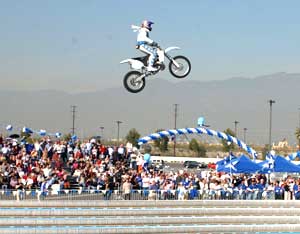Go at them from all angles!!
We were given an example of a product called Dawn Dishwashing Liquid. In 2004, with the help Marina Maher Communications Inc., Dawn created a massive marketing campaign to promote their long lasting dish washing liquid. The issue that Dawn was running into was that competitors were offering larger bottles with the same price thus it seemed that those liquids would last longer. MMC decided to create campaign where a daredevil would jump over 10 000 dishes (signifying the amount of dishes Dawn's liquid could wash) with a motorcycle. The product and event was advertised in the majority of the most followed TV-programs and bi-lingual flyers were given out to reach out to the Hispanic audience. In the end the campaign reached 64 million people in just a week.
http://prcouncil.net/resources/dawn-dishes-it-out-changing-consumers-perceptions-on-value/

The session's main problem:
Integrated Marketing Communication (IMC)
With three learning objectives:
1) What is IMC and what does it mean for a company to follow IMC (is it a strategic or an operational tool)?
2) Who are in charge of IMC? What are the roles of the company and the different agencies (such as marketing/brand/communication/advertising/media/research agencies)?
3) How does/should the client company follow IMC? What are the roles of its different agencies?

1) What is IMC and what does it mean for a company to follow IMC (is it a strategic or an operational tool)?
Integrated Marketing Communications is a simple concept. It ensures that all forms of communications and messages are carefully linked together. At its most basic level, Integrated Marketing Communications, or IMC, means integrating all the promotional tools, so that they work together in harmony. All of these communications tools work better if they work together in harmony rather than in isolation. Their sum is greater than their parts – providing they speak consistently with one voice all the time, every time.
This is enhanced when integration goes beyond just the basic communications tools. There are other levels of integration such as Horizontal, Vertical, Internal, External and Data integration. Here is how they help to strengthen Integrated Communications.
- Horizontal Integration occurs across the marketing mix and across business functions – for example, production, finance, distribution and communications should work together and be conscious that their decisions and actions send messages to customers.
- While different departments such as sales, direct mail and advertising can help each other through Data Integration. This requires a marketing information system which collects and shares relevant data across different departments.
- Vertical Integration means marketing and communications objectives must support the higher level corporate objectives and corporate missions.
- Meanwhile Internal Integration requires internal marketing – keeping all staff informed and motivated about any new developments from new advertisements, to new corporate identities, new service standards, new strategic partners and so on.
- External Integration, on the other hand, requires external partners such as advertising and PR agencies to work closely together to deliver a single seamless solution – a cohesive message – an integrated message. (MMC)
Traditionally, definitions of integrated marketing focus on integrated marketing communications (IMC), but we believe these are no longer fit for purpose, since they imply an old media mindset of campaigns with broadcast and push communications that are one-way and not interactive. Digital media and the web have brought us the opportunity to share via social media (including UGC, user generated content) and create immersive experiences on websites and in mobile apps. We can also personalise across ads, website and email through techniques like re-targeting and website personalisation.
We also need to plan our communications around cross-device usage to reach what comScore rightly highlight as the Multichannel majority and to consider we should look beyond burst campaigns to longer-term continuous online visibility as people and businesses look for our products, services and brands, which Gartner have called Two-speed marketing. (SmartInsights)
Sources:
http://multimediamarketing.com/mkc/marketingcommunications/
http://www.smartinsights.com/traffic-building-strategy/integrated-marketing-communications/what-is-integrated-marketing/